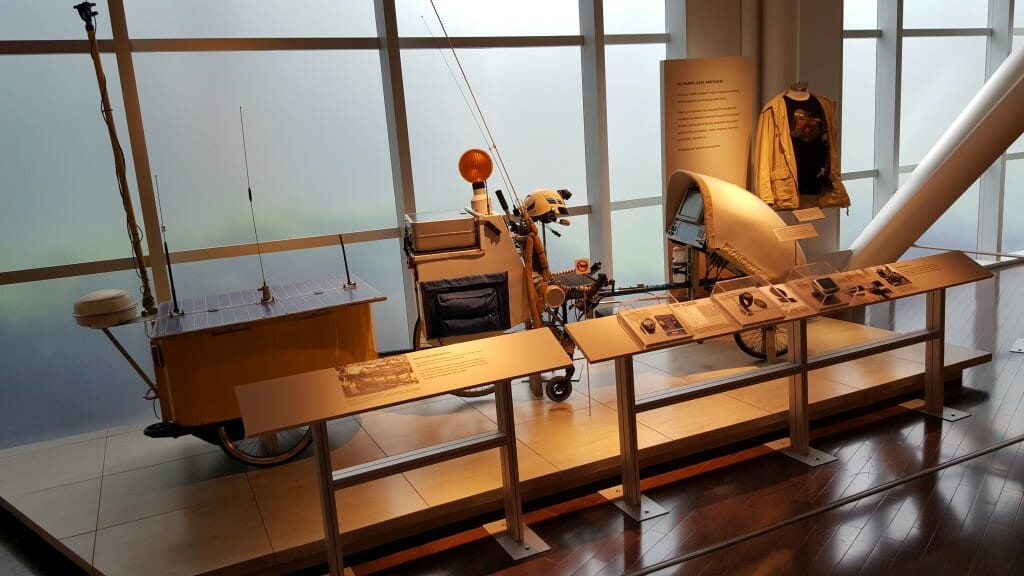
BEHEMOTH – Computer History Museum
The long-term home for the bike, after 17,000 miles of adventure and hundreds of stage appearances in the years that followed, is the Computer History Museum in Silicon Valley. I love this place, and it’s truly worth a visit for lots of reasons besides BEHEMOTH… they have astounding treasures from all branches of the computer world. The photo here is the bike in their Revolution exhibit, and the text following is from their CORE publication.
The BEHEMOTH
CORE 2.1
March, 2001
BEHEMOTH. Big Electronic Human-Energized Machine…Only Too Heavy (1983-1991), L2003.2001. Loaned by Steve Roberts
After speaking at a Museum lecture on Sept 7, 2000. Steve Roberts presented BEHEMOTH to The Computer Museum History Center as a long term loan. (See video below)
In the early 1980s, feeling trapped in his suburban lifestyle, Steve Roberts began to reevaluate his life. Roberts, a freelance technical writer who had published articles in magazines such as Byte, decided to tour the country on a recumbent bicycle of his own design, the Winnebiko. During his trip, Roberts made his living publishing stories and writing a book as he went along, using his on-board Radio Shack TRS-80 Model 100 and a CompuServe account to email his stories to publishers.
After redesigning the bike (as Winnebiko II), Roberts went off in an entirely different direction, devising BEHEMOTH (Big Electronic Human-Energized Machine…Only Too Heavy): a 580-pound, 105-speed recumbent bicycle with a four-foot yellow trailer solar panel array that allowed the incorporation of many more technologies than on previous bikes. Roberts envisioned a project where a “computer and communication tools rendered physical location irrelevant.” BEHEMOTH sported antennas for communication over various amateur and public radio networks, several networked computers (including an Apple Macintosh and an Intel 386-based laptop), a special keypad on each bicycle handle to allow typing, and a security system that would alert police if the vehicle were disturbed. The helmet is perhaps the most futuristic-looking part of BEHEMOTH, with its heads-up display, motion sensors for cursor control, lights, fluid heat exchanger to keep the head cool, and audio system. A complete feature list is shown below.
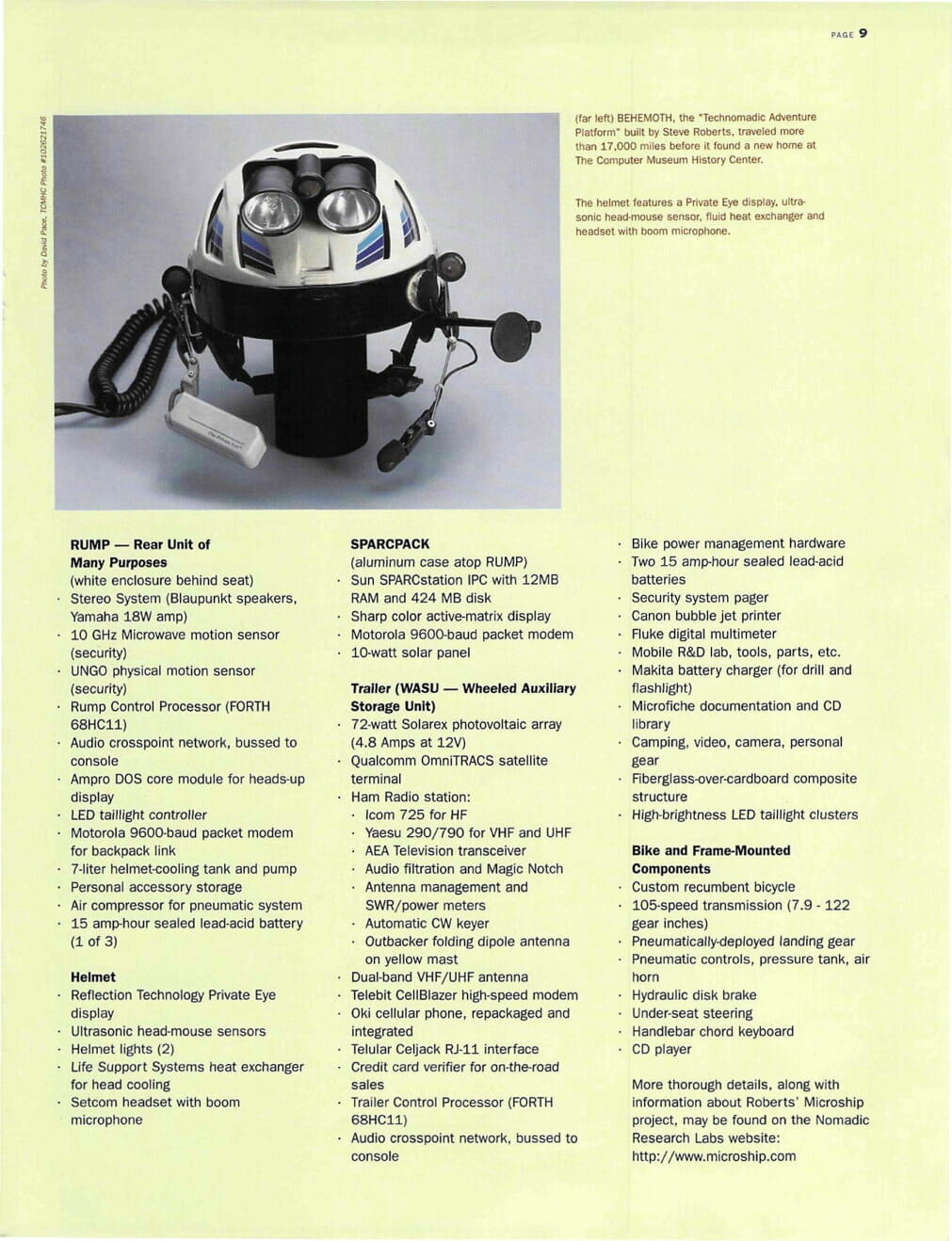
Roberts logged over 17,000 miles on BEHEMOTH and gave hundreds of radio, television, and print interviews over the several years he was on the road. This wide exposure points to BEHEMOTH as an important milestone in the integration of technologies for recreational use, as well as a highly visible artifact of early wireless mobile networking. Roberts retired BEHEMOTH to begin a new project called the Microship.
INTEGRATED EQUIPMENT
Console (forward enclosure under fiberglass hood)
- Macintosh 68K (control GUI and primary workspace)
- Bicycle Control Processor (FORTH 68HC11)
- Ampro 286 DOS platform for CAD system
- Toshiba 1000 repackaged laptop for scrolling FAQ
- 80 MB hard disk space
- Audapter speech synthesizer
- Speech recognition board
- Trimble GPS satellite navigation receiver
- Audio and serial crosspoint switch networks (homebrew)
- PacComm packet TNC (VHF datacomm)
- MFJ 1278 for AMTOR (HF datacomm)
- Diagnostic tools (LED matrix, DPM, etc)
- Handlebar keyboard processor
- Ultrasonic head mouse controller
- Icom 2-meter transceiver
- Radiation monitor
- Cordless phone and answering machine on RJ-11 bus
- Folding 6-segment aluminum console
- Fiberglass fairing
RUMP — Rear Unit of Many Purposes (white enclosure behind seat)
- Stereo System (Blaupunkt speakers, Yamaha 18W amp)
- 10 GHz Microwave motion sensor (security)
- UNGO physical motion sensor (security)
- Rump Control Processor (FORTH 68HC11)
- Audio crosspoint network, bussed to console
- Ampro DOS core module for heads-up display
- LED taillight controller
- Motorola 9600-baud packet modem for backpack link
- 7-liter helmet-cooling tank and pump
- Personal accessory storage
- Air compressor for pneumatic system
- 15 amp-hour sealed lead-acid battery (1 of 3)
Helmet
- Reflection Technology Private Eye display
- Ultrasonic head-mouse sensors
- Helmet lights (2)
- Life Support Systems heat exchanger for head cooling
- Setcom headset with boom microphone
SPARCPACK (aluminum case atop RUMP)
- Sun SPARCstation IPC with 12MB RAM and 424 MB disk
- Sharp color active-matrix display
- Motorola 9600-baud packet modem
- 10-watt solar panel
Trailer (WASU — Wheeled Auxiliary Storage Unit)
- 72-watt Solarex photovoltaic array (4.8 Amps at 12V)
- Qualcomm OmniTRACS satellite terminal
- Ham Radio station:
• Icom 725 for HF
• Yaesu 290/790 for VHF and UHF
• AEA Television transceiver
• Audio filtration and Magic Notch
• Antenna management and SWR/power meters
• Automatic CW keyer
• Outbacker folding dipole antenna on yellow mast - Dual-band VHF/UHF antenna
- Telebit CellBlazer high-speed modem
- Oki cellular phone, repackaged and integrated
- Telular Celjack RJ-11 interface
- Credit card verifier for on-the-road sales
- Trailer Control Processor (FORTH 68HC11)
- Audio crosspoint network, bussed to console
- Bike power management hardware
- Two 15 amp-hour sealed lead-acid batteries
- Security system pager
- Canon bubble jet printer
- Fluke digital multimeter
- Mobile R&D lab, tools, parts, etc.
- Makita battery charger (for drill and flashlight)
- Microfiche documentation and CD library
- Camping, video, camera, personal gear
- Fiberglass-over-cardboard composite structure
- High-brightness LED taillight clusters
Bike and Frame-Mounted Components
- Custom recumbent bicycle
- 105-speed transmission (7.9 -122 gear inches)
- Pneumatically-deployed landing gear
- Pneumatic controls, pressure tank, air horn
- Hydraulic disk brake
- Under-seat steering
- Handlebar chord keyboard
- CD player
More thorough details, along with information about Roberts’ Microship project, may be found on the Nomadic Research Labs website.
Resources
Here is my talk on the night the bike was donated to the museum (Sept 7, 2000):
I had a chance to visit the museum again in May of 2015…
Note from 2018 – there is a delightful post on the Japanese Critical Cycling blog (October 2017) about seeing BEHEMOTH in the museum… click the pop-up to translate!



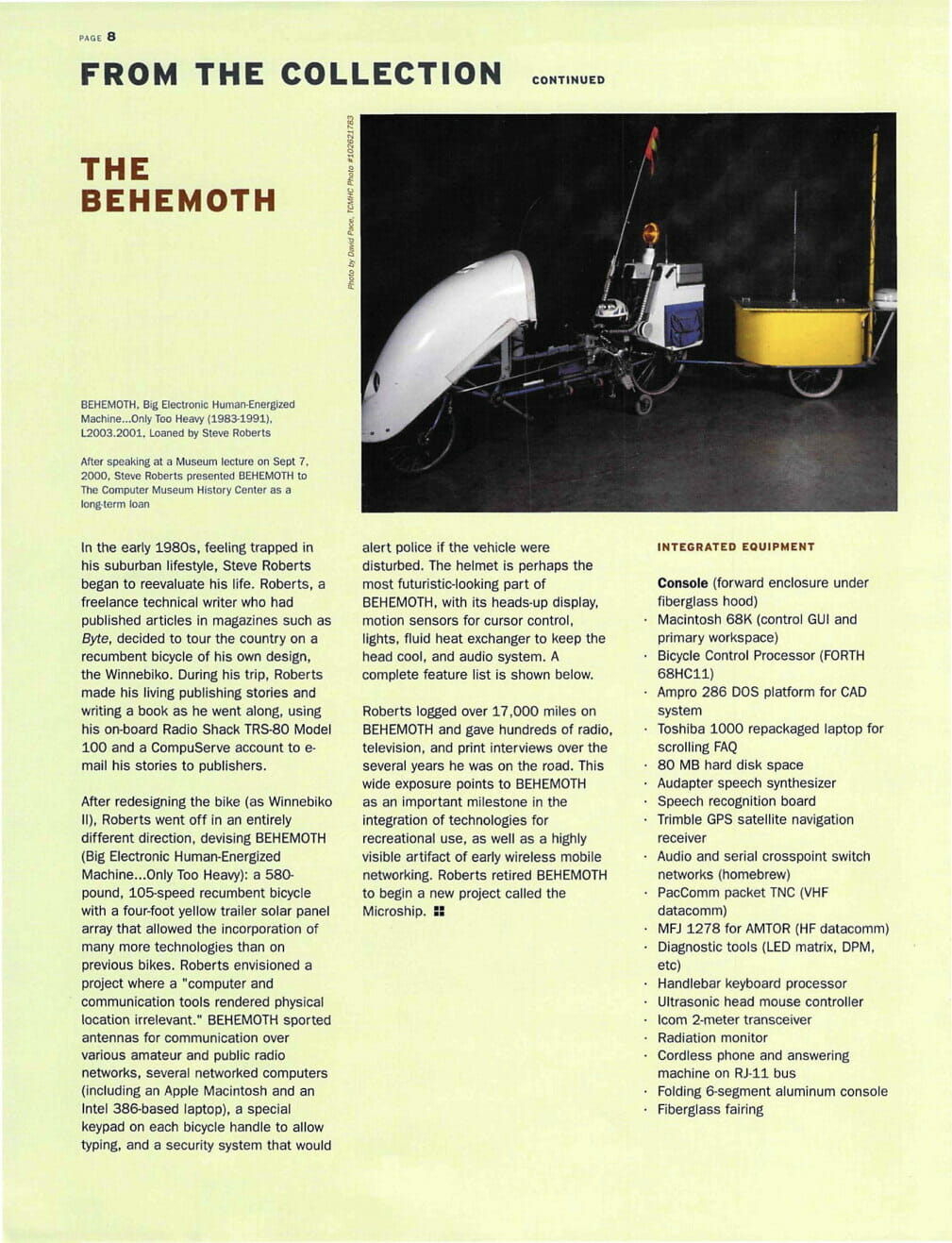
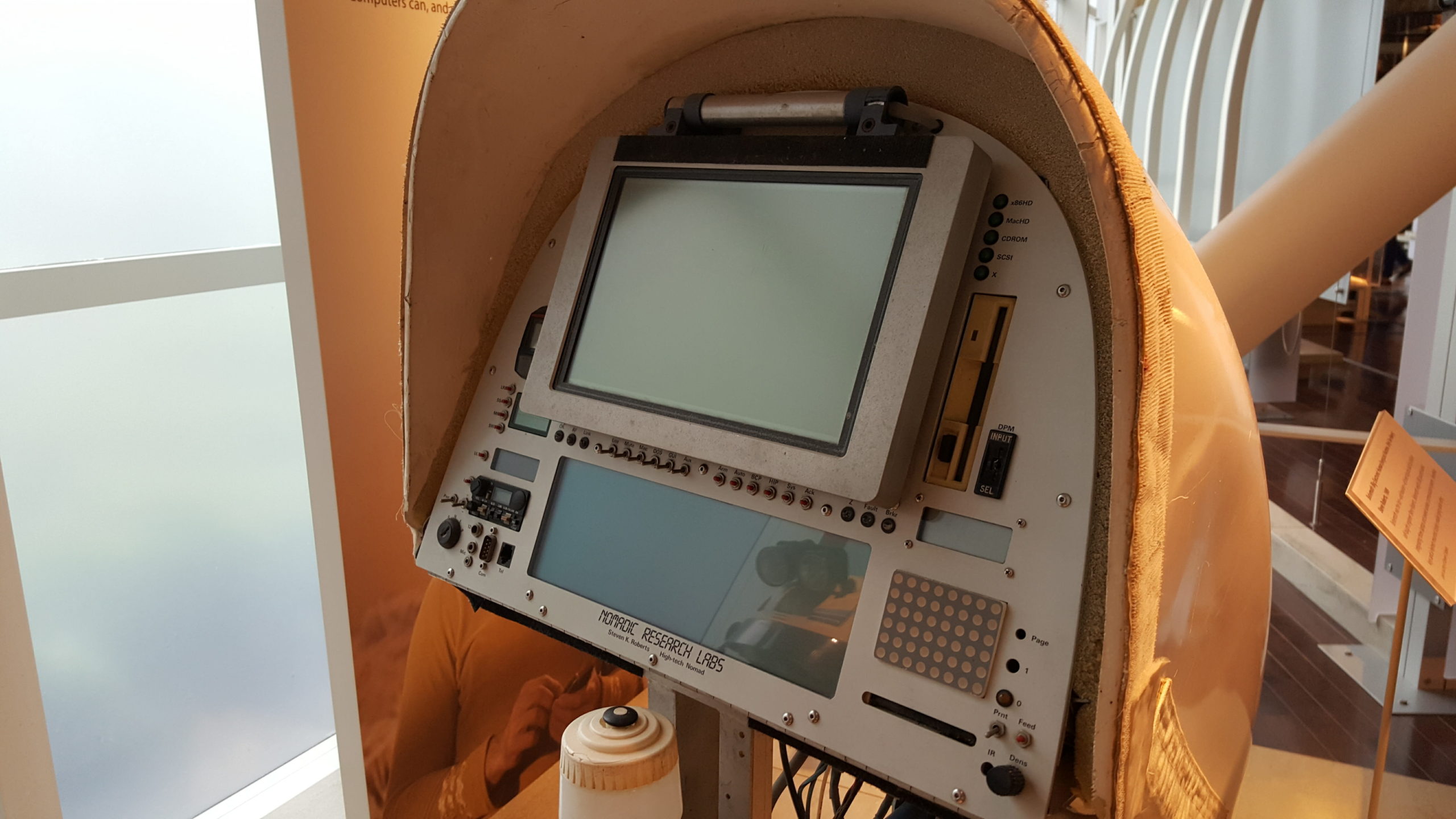
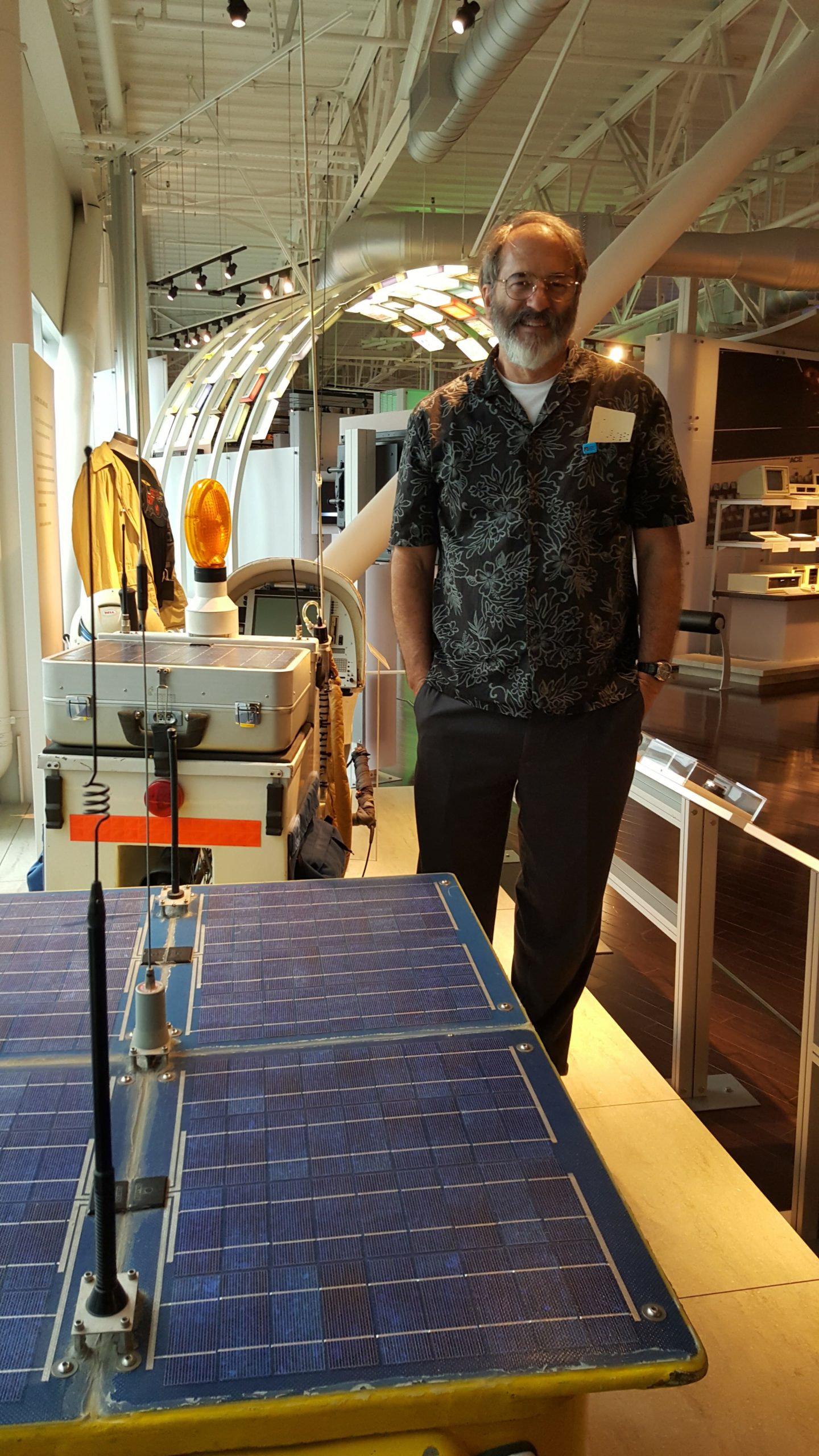
[…] in May of 2015, a trip that included a week-long visit with a group at Google, a pilgrimage to the Computer History Museum to see BEHEMOTH, and an afternoon at the Maker Faire. The surreal week in the Googleplex began with […]
[…] One of the most visually distinctive components of the BEHEMOTH bicycle system was the BIU, or Brain Interface Unit. This was based on a Bell Tourlite helmet, and included a head-mounted display, three ultrasonic sensors for cursor control, stereo and communications headsets, boom microphone, spot and flood lights, rear-view mirror, and a heat-exchanger to help shed body heat. I had a bit of fun writing about this in the old Nomadness journal (issue #9, Fall 1990), and that deliberately playful-but-accurate text is below… along with a schematic and a few other technical details. This helmet, along with the bike, is now on display in the Computer History Museum. […]